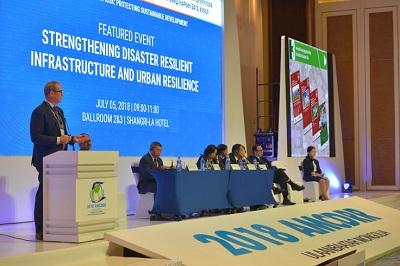
CEO of the Queensland Reconstruction Authority, Brendan Moon, explains the value of investing in disaster resilient infrastructure
By Patrick Fuller
ULAANBAATAR, 5 July 2018 - It is estimated that $1.7 trillion will be required annually to meet demand for new infrastructure in Asia over the next twelve years including $200 billion to ensure that new infrastructure is resilient to disasters and climate-related events.
This sobering statistic was cited by Dr. P. K Mishra, Additional Principal Secretary in the Prime Minister’s Office of India, who set the stage for a featured event today on Strengthening Disaster Resilient Infrastructure and Urban Resilience, at the 2018 Asian Ministerial Conference on Disaster Risk Reduction (AMCDRR 2018).
“Although steady progress is being made in reducing mortality from disasters, it will be nearly impossible to achieve the targets of the Sendai Framework for Disaster Risk Reduction of reducing the number of people affected by disasters and reducing the economic and infrastructure losses - unless disaster risk reduction is mainstreamed across multiple development sectors,” said Dr. Mishra.
A large chunk of the new investment in infrastructure will come from the private sector.
“Investment in disaster resilient infrastructure needs to be seen not as an additional expense but as an opportunity to create shared value for businesses and society,” he said.
At the 2016 AMCDRR held in Delhi, the Indian Prime Minister Narendra Modi announced that India would work with other countries and the UN to form a coalition on disaster reliant infrastructure.
Earlier this year a first meeting was held in collaboration with the United Nations Office for Disaster Risk Reduction (UNISDR) that brought together 150 experts from more than 21 countries including UN agencies, multilateral banks, the private sector and academia. India has allocated $10 million as a seed fund to support the initiative.
Globally, over the next 15 years, global disaster losses in the built environment are estimated at $415 billion.
“Such disaster losses in terms of infrastructure and development are preventable with the right decisions”, said Ms. Mizutori, the UN Secretary-General’s Special Representative for Disaster Risk Reduction.
“The way we build our infrastructure today will either build risk or resilience for future generations. The path of resilience is open to us – if we so choose”.